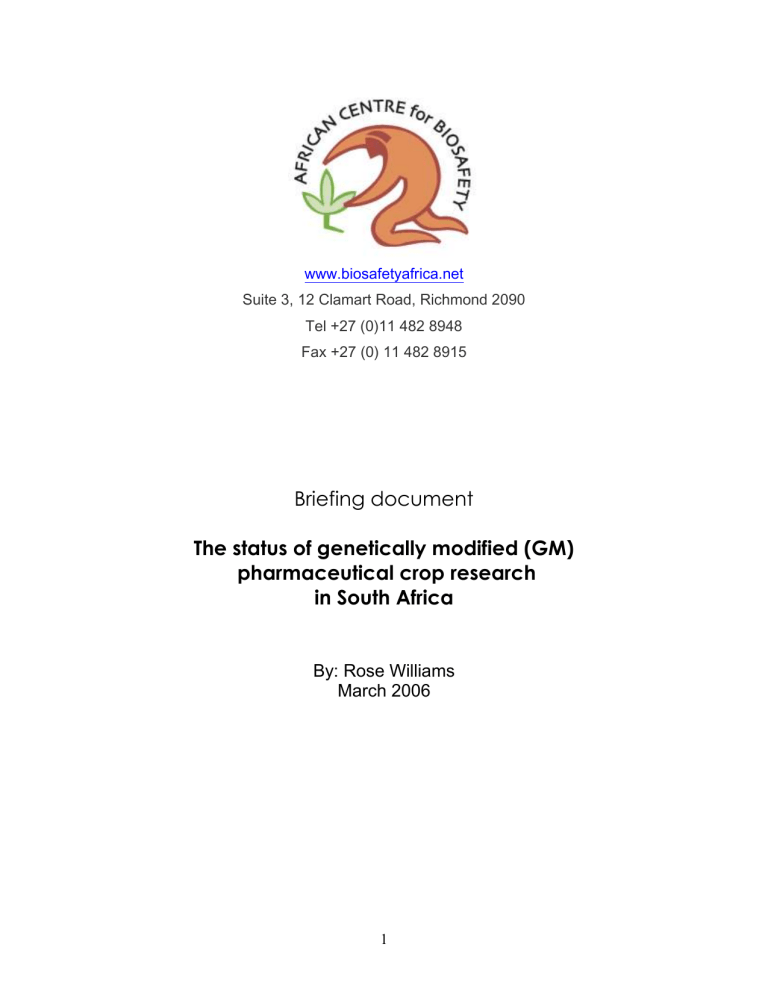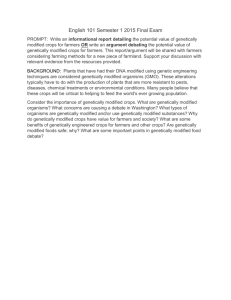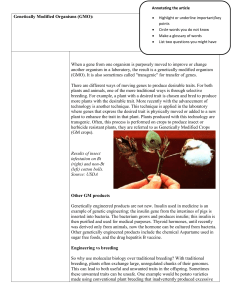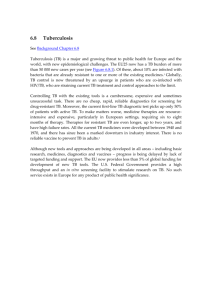Pharmaceutical Crop Research (English - doc - 304 Kb)

www.biosafetyafrica.net
Suite 3, 12 Clamart Road, Richmond 2090
Tel +27 (0)11 482 8948
Fax +27 (0) 11 482 8915
Briefing document
The status of genetically modified (GM)
pharmaceutical crop research in South Africa
By: Rose Williams
March 2006
1
CONTENTS
What are GM pharmaceutical crops?
Determining the status of GM pharmaceutical crop research in South Africa
Pharma-crop facilities in South Africa
Conclusion
Recommendations
References
Annexures 1 and 2
2
THE STATUS OF GENETICALLY MODIFIED (GM)
PHARMACEUTICAL CROP RESEARCH
IN SOUTH AFRICA
WHAT ARE GM PHARMACEUTICAL CROPS?
Genetically modified (GM) pharmaceutical crops are crops which have been genetically engineered / modified to produce pharmaceuticals. These pharmaceuticals can be vaccines, antibodies or therapeutic proteins. The crops are often known as “pharmacrops”.
Pharma-crops are a contested and little-known terrain, with remarkable benefits being claimed for them in South Africa – edible vaccines that will be easy to consume, vaccines to alleviate the desperate HIV/AIDS situation, supply of low cost drugs, added value to crops … whilst other voices ask about contamination of the food supply and the environmental and social costs of this technology.
Internationally, commercial GM plant-derived pharmaceuticals are not available, but there are GM plant-derived pharmaceutical proteins which are said to be approaching commercial release.
1 But what is the situation in South Africa? What sort of research is being done, where is it being done, who is funding it, what plants are being used, what pharmaceuticals are being produced, at what level is the research being done?
DETERMINING THE STATUS OF GM PHARMACEUTICAL CROP RESEARCH IN
SOUTH AFRICA
What is the reality in South Africa? The regulatory framework governing GMO’s in South
Africa requires that: i) permits are needed to “… import or export from the Republic of South Africa, or develop, produce, use, release or distribute any genetically modified organism in the Republic of South Africa”… 2 , except in the case of: ii) GMO’s that are “… used under conditions of contained use in academic and research facilities, and for those organisms listed in Table 3 of the Annexure” 3 .
The list of permits issued from 1999 to date, by the Department of Agriculture, are on the
Department’s website. Permits are given for Contained use, Trial release, General release and Commodity clearance. None of the permits, and there have been many of them, have been for GM pharmaceutical crops.
1 “Plant-derived pharmaceuticals – the road forward.” TRENDS in Plant Science Vol. 10. No.12 Page 580
December 2005
2 Department of Agriculture. 1999 Regulations within the framework of the Genetically Modified
Organisms Act (No. 15 of 1997): Regulation 2. (1)
3 Department of Agriculture. 1999 Regulations within the framework of the Genetically Modified
Organisms Act (No. 15 of 1997): Regulation 2. (2)
3
A list with certain details of the 48 academic and research facilities that have been registered with the Department of Agriculture from May 2000 to January 2006, was made available by the Department. According to the Department’s Standard Operating
Procedures for (academic and research) facilities, an import permit or a permit authorizing contained use is not needed, provided that:
(a)
(b)
(c)
(d)
(e)
(f)
(g)
(h)
The GMO will only be used within a research or academic facility;
The activity is for research or academic purposes only;
The confined area within the facility is a laboratory or growth room;
The confined area within the facility is a greenhouse (glasshouse), provided that the greenhouse
(glasshouse) is not used for bulking-up or commercial production purposes;
The facility is registered in terms of Regulation 4 of the GMO Act;
The level of containment is not higher that 2, which has been verified by the Advisory Committee during registration of the facility;
The GMO will not be removed from the facility or released into the environment;
The responsible individual in charge of the facility implements the necessary measures to effectively contain the GMO at all times.
4
A contained use permit is required once the research is scaled up from basic research to product development, or when conducting the activities in a greenhouse or when the containment level is 3 and above.
5
If the facilities are working on GMO’s on an ongoing basis, then they need to renew their registration on an annual basis as registration is valid for a maximum period of one year.
The 48 facilities that have been registered, but not all of them currently, are housed in 26 institutions (see Annexure 1). The details given for each facility usually included information on the location of the facility, the responsible person, type of facility, containment level, purpose of genetic modification and a list of genetically modified organisms.
Of the 48 facilities, 33 were contacted to check if they were involved in GM pharmaceutical crop research. This was done as it was not always possible from the information provided by the Department, to determine whether research was on GM pharmaceutical crops or not. For example, in the section on the purpose of genetic modification, “crop improvement strategies”, “ introduce high price products into plants”,
“production of proteins” may be given or in some cases no information was provided.
The remainder of the facilities were not contacted because it was clear from the information provided that they were not involved in GM pharmaceutical crop research. Of the 48 facilities registered, two have GM pharmaceutical crop research projects that fall under their jurisdiction. These are listed here, with their involvement in GM pharmaceutical crop research discussed later on:
1. CSIR-BIO/CHEMTEK Department (Brummeria) as one of the partners of the
Pharma-Planta Consortium
2. University of Cape Town, Department of Molecular and Cell Biology
(Rondebosch) with their Plant-Based Vaccines Group
4 Department of Agriculture: Standard Operating Procedures for implementing Regulation 2(2) of the
Genetically Modified Organisms (GMO) Act, 1997 (Act No. 15 of 1997)
5 Department of Agriculture: “Application to register a facility for activities involving genetic modification”
4
It should also be noted that none of the organisms listed in Table 3 of the 1997
Regulations or in the annexure of the previously mentioned Standard Operating
Procedures, relate to GM pharmaceutical crops.
PHARMA-CROP FACILITIES IN SOUTH AFRICA
1. Pharma-Planta
Pharma-Planta is a research consortium representing 39 academic and industrial institutions, 38 of them from Europe and the CSIR (Council for Scientific and Industrial
Research) from South Africa (see Annexure 2). Pharma-Planta was launched in 2004 and is funded by the European Union, under the Framework 6 programme for Research and Development, for an amount of 12 million Euros over five years.
The mission of the PharmaPlanta Consortium is “to develop efficient and safe strategies for the production of clinical-grade protein pharmaceuticals in plants, and to define procedures and methods for the production of these proteins in compliance with all appropriate regulations”.
6 The pharmaceuticals planned are for vaccines and treatments against major diseases including AIDS, diabetes, rabies and TB.
Although the CSIR has been working on genetically modified maize, grain sorghum and millet for many years and has “expertise, infrastructure and production capabilities for breeding and bulking up of genetically transformed maize” 7 , the work under the Pharma-
Planta project is at a basic research level. The staff consists of two doctoral and two
M.Sc. graduates and one greenhouse assistant.
The research is on transforming maize to produce antibodies that have neutralizing activity against HIV, and on transforming tobacco to produce antibodies that have neutralizing activity against rabies.
The change from basic research to product development is contingent on the outcome of the exploratory work. It is anticipated that this shift will only be made in the fifth year if all goes well.
Currently there are no plans for field experimentation or general release.
8
In 2004, it was postulated in the United Kingdom that as a result of the Pharma-Planta work that “Scientists will probably carry out the first field trials (of vaccine-producing plants) in South Africa in 2006, because researchers feared the possibility of crop vandalism in the United Kingdom, where some activists have in the past destroyed GM crops” 9 . However, the CSIR has stated that no decision has been made as to whether
South Africa will be the test site for the first pharmaceutical crops.
10 Spain and the
United Kingdom were mentioned as other possibilities besides South Africa for this.
It was emphasized by the CSIR that issues around food security would be dealt with, that different regulations are needed for pharmaceutical crops as opposed to food crops and that Standard Operating Procedures for the Pharma-Planta project are being worked on.
6 http://www.pharma-planta.org/description.htm
7 CSIR media statement “The CSIR, South Africa and Project Pharmaplanta” July 2004
8 Dr Rachel Chikwamba, CSIR pers. comm. 23 February 2006
9 Steve Connor “GM plants will be used to create Aids vaccine”. The Independent, 13 July 2004
10 Dr Dusty Gardiner, CSIR pers. comm. 14 Dec 2005
5
Funding for the Pharma-Planta work in South Africa is from the CSIR and the EU. There are no commercial partners and no multinational involvement. The level of funding is contingent upon the outcome of the exploratory research that they are currently involved in.
11 However, a figure of between R5 – R10 million was mentioned for the 5 year project.
12
2. Plant-Based Vaccines Group
This is an informal grouping in the Departments of Molecular and Cell Biology (MCB) and the Institute of Infectious Diseases and Molecular Medicine (IIDM), in collaboration with the BIOVAC Institute.
The Plant-Based Vaccines Group is working on a Human Papilloma Virus (HPV) plant based vaccine and a HIV plant based vaccine. In both instances the plant used is tobacco, Nicotiana tabacum and Nicotiana benthamiana .
There is also a plan to attempt to produce influenza virus haemagglutinin protein in plants soon as well as short chain variable region antibodies derived from chickens.
There are no plans for field trials as the intention is for the plants would be grown in an indoor or quarantine glasshouse.
13 a) Human Papilloma Virus (HPV) plant based vaccine
The status of the work has changed from pure research to largely developmental with two candidate vaccines for HPV (HPV thought to be the major cause of cervical cancer).
The one vaccine is a novel chimaeric capsid protein produced via recombinant baculovirus, whilst the other is a conventional capsid protein vaccine produced in plants.
Scale-up of production and purification is being investigated. The vaccine has been in animals (mice) and there is the intention of non-human primate trails soon and only after that could consideration be given to human trials.
14
This research is currently funded through the Innovation Fund of the National Research
Foundation (NRF) / Department of Science and Technology (DST) and the Poliomyelitis
Research Foundation. Previous funding was from The Technology and Human
Resources Industry Programme (THRIP), managed on behalf of the National Research
Foundation on behalf of the Department of Trade and Industry (the dti) and the Cancer
Association of South (CANSA).
b) HIV plant based vaccine
The status of this work is preliminary and is funded by the SA AIDS Vaccine
Initiative (SAAVI).
3. Other facilities
There has been some interest expressed in genetically modified pharmaceutical crops by other registered facilities, but at present there are no plans to do this work. In one facility, the ARC-Roodeplaat Vegetable & Ornamental Plant Institute, it was noted under the Purpose of Genetic Modification “…. is also involved in the development of transgenic plants as biofactories for the inexpensive production of high value proteins
11 Dr Rachel Chikwamba, CSIR pers. comm. 23 February 2006
12 Dr Dusty Gardiner, CSIR pers. comm. 14 Dec 2005
13 Prof. Ed. Rybicki, UCT pers.comm. 27 February 2006
14 Prof. Ed. Rybicki, UCT pers.comm. 27 February 2006
6
such as vaccines, enzymes, etc.”. However there are no plans at Roodeplaat to work on pharmaceutical crops in the foreseeable future.
15
CONCLUSION
Currently there are no genetically modified pharmaceutical crops grown in South Africa.
Of the 48 academic and research facilities that have been registered with the
Department of Agriculture to work on genetically modified organisms, only two are directly involved with genetically modified pharmaceutical crop research. These are the
CSIR with their European Union funded Pharma-Planta Consortium and the Department of Molecular and Cell Biology of the University of Cape Town with their Plant-Based
Vaccines Group. Although there has been some interest expressed by some of the facilities to do GM pharmaceutical crop research, currently there are no plans to do this work. Recommendations coming out of this work on “The status of genetically modified pharmaceutical crop research in South Africa” follow:
RECOMMENDATIONS
1. In-depth studies of GM pharmaceutical crop research in SA
In-depth studies need to be done on the GM pharmaceutical crop research done at the two facilities (CSIR and UCT’s Dept of Molecular and Cell Biology). The claims that are made for the research should be analysed, the risk assessments obtained, the finances detailed and the links with partner organizations (inside and outside the country) mapped.
It would be important to know what research work the partner organizations are doing and the details of the genetically modified organisms shipped to SA.
In the case of the CSIR, it would be important to gain access to the Pharma-Planta consortium agreement or at least key portions of it – at the moment it is not able to be made available and neither is the technical information relating to the project.
2. Informing the public
The public needs to be informed about issues (environmental, social and health) around
GM pharma crops. The public need to have easy access to better information than the web hype of edible vaccines in bananas and quick fixes to solve the devastation caused by HIV/AIDS and TB.
National government’s regulatory system does not facilitate easy access to information around GMO work, but national government has a responsibility to the people of South
Africa to make them aware of the issues and particularly those issues around food security. Pharma crops are different to food crops and there is always the risk that there will be contamination of the food supply.
It is recommended that there is a high profile national forum where issues around pharma-crops are raised and that national government makes a concerted effort to see that concerns around pharma-crops are addressed at all levels of government (from policy makers to the agricultural extension officers).
15 Dr Kobie Theron, Roodeplaat Vegetable and Ornamental Plant Institute, pers. comm. February 2006
7
3. South Africa’s biosafety system
South Africa’s biosafety system is widely regarded as being weak (e.g. in terms of liability, public participation, access to information) and the current system does not adequately cater for pharma-crops. The recommendations are: i) ii) iii) easy public access to risk assessments that the biosafety system is developed to provide proper protection in terms of GM pharma-crops, e.g. with respect to food security, liability, Standard
Operating Procedures, human and animal health and environmental impact assessments. that South Africa’s weak biosafety systems and lack of capacity should not be allowed to be exploited by research partners outside the country, e.g. if it’s iv) not possible to do the field trials and commercial growing of pharma crops in
Europe, then it should not be possible here. that the largely self-regulated research done at the registered research and academic facilities should at a far earlier stage be actively regulated by national government and that there should be public participation and easy access to information at a far earlier stage as national interests of food security, human health and environment are at stake. (It would also mean that the millions of rands needed for this type of research could be diverted at an earlier stage, if it was found that the research is, for example, going to negatively impact on food security.)
4. Contamination of Food supply
There is widespread support for not putting pharmaceuticals into food plants. If there are mistakes in the US, (e.g. with Prodigene Inc.’s volunteer transgenic maize growing in a soybean crop one year after the pharmaceutical maize was harvested 16 ), which is supposed to be better equipped than South Africa, there will be mistakes in South Africa.
Contamination of the food supply can occur in the field, mixing of seed, harvesting on the farm, shipping, handling and storage.
The recommendation is for no pharmaceuticals in food plants, which means no edible vaccines and no pharmaceuticals put into food crops where the pharmaceutical is later extracted! Don’t use food plants for pharma-crops.
5. Financing of GM plant-derived pharmaceuticals
The claims of cheap GM plantderived pharmaceuticals (vaccines, proteins …) through
GM pharmaceutical crops needs to be assessed. The costing of this from staffing, infrastructure, research funds, production and commercialization, liability and social and environmental impacts needs to be included. Much public money is going towards this work. Should this be the case? Will the products do what they say they will do and will the pr oducts be “safe”?
16 “Plant-derived pharmaceuticals – the road forward.” TRENDS in Plant Science Vol. 10. No.12 Page 581
December 2005
8
REFERENCES
Andow, D. et al.
“A growing concern: protecting the food supply in an era of pharmaceutical and industrial crops”. 2004.
Union of Concerned Scientists.
Department of Agriculture, South Africa. Genetically Modified Organisms Act, 1997 (Act No. 15 of
1997).
Department of Agriculture, South Africa. Regulation 1420. 26 November 1999. Genetically
Modified Organisms Act, 1997 (Act No. 15 of 1997).
Department of Agriculture, South Africa. May 2004. Guideline document for work with genetically modified organisms. Genetically Modified Organisms Act, 1997 (Act No. 15 of 1997).
Department of Agriculture, South Africa. 2005. Genetically Modified Organisms Amendment Bill.
Freese, B. & Caplan, R. “Plant-made pharmaceuticals Financial Risk Profile”. January 2006.
Friends of the Earth and U.S. Public Interest Research Group.
Ma, J KC, Chikwamba, R., Sparrow, P. Fischer, R., Mahoney R. and Twyman, R.M. “Plantderived pharmaceuticals – the road forward”. TRENDS in Plant Science Vol. 10. No.12 December
2005.
Ma, J K-C, et al “Molecular farming for new drugs and vaccines. Current perspectives on the production of pharmaceuticals in transgenic plants”. EMBO Reports 6: 593-599. 2005.
Mayer, S. “Non-food GM Crops: new dawn or false hope?” August 2003. Part 1: Drug Production.
GeneWatch UK Report.
Websites www.mcb.uct.ac.za/plant_vaccines.htm
Plant-Based Vaccines Group www.nda.agric.za
Department of Agriculture, South Africa www.pharmaplanta.org
Pharma-Planta consortium www.pub.ac.za
Public Understanding of Biotechnology (PUB), Department of Science &
Technology www.twnside.org.sg
Third World Network
9
Annexure 1
LIST OF FACILITIES registered with the Registrar of the Genetically Modified Organisms Act,
Department of Agriculture
May 2000
– January 2006
17
1.
NAME OF FACILITY
AECI-BIOPRODUCTS (PTY) LTD
(see also no. 13)
2.
AGRICULTURAL RESEARCH COUNCIL (ARC)
ARC- Grain Crops Research
3. ARC-INFRUITEC-NIETVOORBIJ
4. ARC – Livestock Business Division Irene
5. ARC-PLANT PROTECTION RESEARCH INSTITUTE
(Onderstepoort Veterinary Institute)
6. ARC-PLANT PROTECTION RESEARCH INSTITUTE
7. ARC-ROODEPLAAT VEGETABLE & ORNAMENTAL PLANT
INSTITUTE
8. ARC-ROODEPLAAT VEGETABLE & ORNAMENTAL PLANT
INSTITUTE
9. AMPHIGRO CC
10. BIOVAC INSTITUTE
CSIR
11. CSIR-BIO/CHEMTEK Department
12. CSIR-BIO/CHEMTEK Department
13. CSIR-BIO/CHEMTEK Department
14. FRONTIER LABORATORIES CC.
15. MEDICAL RESEARCH COUNCIL
16. MOLECULAR DIAGNOSTIC SERVICES
17. NATAL BIOPRODUCTS INSTITUTE
NATIONAL BIOPRODUCTS INSTITUTE
(name change from above)
18. NATIONAL HEALTH LABORATORY SERVICES
19. OUDSPAN CITRUS CENTRE
AREA and postal code
Umbogintwini 4120
Potchefstroom 2520
Stellenbosch 7599
Irene 0062
Onderstepoort 0110
Pretoria 0001
Pretoria 0001
Pretoria 0001
Monument Park 0181
Pinelands 7430
Brummeria 0148
Modderfontein 1645
Modderfontein 1645
Dennesig 7601
Tygerberg 7570
Westville 3630
Cape Town 7000
Pinetown 3600
Johannesburg 2000
Centralhill 6006
17 List compiled from information supplied by the Registrar of the GMO Act on 10 January 2006.
Note: renewals and new applications may have been received since this date, registration is valid for a maximum period of one year.
10
20. PANNAR (PTY) LTD
See
1.
SOUTH AFRICAN BIOPRODUCTS (was AECI-BIOPRODUCTS)
21. SOUTH AFRICAN BIOPRODUCTS APPLYIT (PTY) LTD
22. SOUTH AFRICAN BIOPRODUCTS
23. SOUTH AFRICAN BIOPRODUCTS
24. SAPPI FORESTS (PTY) LTD
25. SA SUGAR ASSOCIATION EXPERIMENT STATION
UNIVERSITY OF CAPE TOWN
26. UNIVERSITY OF CAPE TOWN
(Department of Molecular and Cell Biology)
27. UNIVERSITY OF CAPE TOWN
(Department of Human Biology)
28. UNIVERSITY OF KWAZULU-NATAL
29. UNIVERSITY OF FREE STATE
30. UNIVERSITY OF PORT ELIZABETH
UNIVERSITY OF NORTH WEST
31. UNIVERSITY OF POTCHEFSTROOM now University of North-West (Potchefstroom campus)
32. UNIVERSITY OF NORTH-WEST
33. UNIVERSITY OF PRETORIA
UNIVERSITY OF STELLENBOSCH
34. UNIVERSITY OF STELLENBOSCH
(Institute for Plant Biotechnology)
35. UNIVERSITY OF STELLENBOSCH
(Institute for Wine Biotechnology)
36. UNIVERSITY OF STELLENBOSCH
(Department of Microbiology)
See
15.
UNIVERSITY OF STELLENBOSCH
(Medical Research Council)
37. UNIVERSITY OF STELLENBOSCH
(Department of Medical Virology)
38. UNIVERSITY OF STELLENBOSCH
(Agricultural Research Council – INFRUITEC)
39. UNIVERSITY OF STELLENBOSCH
(Dept of Biochemistry)
40. UNIVERSITY OF STELLENBOSCH
(Department of Genetics)
41. UNIVERSITY OF STELLENBOSCH
(Department of Genetics)
42. UNIVERSITY OF STELLENBOSCH
(Department of Genetics)
43. UNIVERSITY OF STELLENBOSCH
Greytown 3250
Umbogintwini 4120
Westway 3635
Umbogintwini 4120
Umbogintwini 4120
Howick 3290
Mount Edgecombe
4300
Rondebosch 7000
Observatory 7925
Pietermaritzburg 3209
Bloemfontein 9300
Port Elizabeth 6000
Potchefstroom 2520
Potchefstroom 2520
Pretoria 0001
Matieland 7602
Stellenbosch 7599
Matieland 7602
Tygerberg 7570
Tygerberg 7570
Stellenbosch 7599
Matieland 7602
Matieland 7602
Matieland 7602
Matieland 7602
Matieland 7602
11
(Department of Genetics)
44. UNIVERSITY OF THE NORTH
(Biotechnology unit)
45. UNIVERSITY OF THE WITWATERSRAND
(Department of Molecular Medicine and Haematology)
46. RHODES UNIVERSITY
(Department of Biochemistry and Microbiology)
47 UNIVERSITY OF JOHANNESBURG
(Department of Biochemistry)
48. VINE VET (PTY )LTD
12
Sovenga 0727
Wits 2050
Grahamstown 6140
Auckland Park 2006
Paulhof 2056
Annexure 2
PHARMA-PLANTA
Members of the Consortium
18
Fraunhofer Institute of Molecular Biology and Applied Ecology, Aachen, Germany
St George's Hospital Medical School, London, UK
RheinischWestfälische Technische Hochschule (RWTH), Aachen, Germany
National University of Ireland, Maynooth, Republic of Ireland
John Innes Centre, Norwich, UK
Centre de Cooperation Internationale en Research Agronomique pour le Development
(CIRAD), Paris, France
Oxford Brookes University, Oxford, UK
University of Warwick, Coventry, UK
Universität für Bodenkultur, Vienna, Austria
Polymun Scientific Immunbiologische Forschungs GmbH, Wien, Austria
Universita Degli Studi di Verona, Verona, Italy
Ente per le Nuove Technologie, l'Energia e l'Ambriente, Rome, Italy
Diamyd Medical AB, Stockholm, Sweden
Universite Blaise Pascal Clermont-Ferrand II, Aubiere, France
Institut National de la Recherche Agronomique, Paris, France
University of Cambridge, Cambridge, UK
University of Glasgow, Glasgow, UK
Ruprecht-KarlsUniversität Heidelberg, Heidelberg, Germany
Universite Catholique de Louvain, Lovain-la-Neuve, Belgium
University of Leeds, Leeds, UK
Consiglio Nazionale Delle Ricerche, Rome, Italy
Council for Scientific and Industrial Research (CSIR), Pretoria, South Africa
Rothamstead Research Ltd, Harpenden, UK
Universite de Neuchatel, Neuchatel, Switzerland
Max Planck Institute, Potsdam, Germany
Trinity College, Dublin, Republic of Ireland
Institut für Pflanzengenetik und Kulturpflanzenforschung, Gatersleben, Germany
Vlaams Interuniversitair Instituut voor Biotechnologie VZW, Zwijnaarde, Belgium
Agricultural University of Athens, Athens, Greece
Centre for the Management of Intellectual Property in Health research and Development
(MIHR), London, UK
Mosaic Systems BV, Prinsenbeek, The Netherlands
Univeritat de Lleide, Lleida, Spain
18 http://www.pharmaplanta.org.consortium.htm
13








